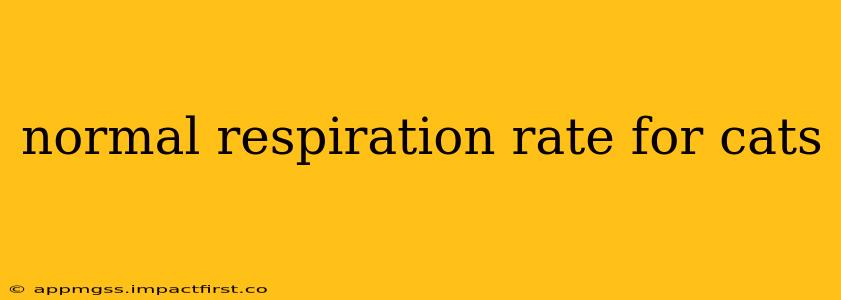Understanding your cat's breathing is crucial for recognizing potential health problems. While a normal respiration rate provides a baseline, variations can occur due to factors like age, activity level, and underlying medical conditions. This guide will delve into the specifics of feline respiration, helping you better understand what's considered normal and when you should seek veterinary attention.
What is the normal respiration rate for cats?
The average respiratory rate for a healthy adult cat at rest is 16 to 30 breaths per minute. However, kittens and senior cats may have slightly higher or lower rates. It's important to remember this is just an average, and slight variations within this range are perfectly normal. Factors like temperature, stress, and exertion can also temporarily affect breathing rate.
How to check your cat's breathing rate?
Accurately assessing your cat's breathing requires a calm and patient approach. Here's how:
- Find a comfortable spot: Ensure your cat is relaxed and not feeling threatened. A quiet environment is key.
- Observe their chest and abdomen: Gently observe the rise and fall of your cat's chest and abdomen for one minute. Count each complete breath (one inhale and one exhale) as a single respiration.
- Record the count: Note the number of breaths per minute.
It's best to perform this check when your cat is resting quietly, ideally after a period of rest and not immediately after play or exercise.
What factors can affect a cat's respiratory rate?
Several factors can influence a cat's breathing rate, making it crucial to consider the context. A slightly elevated rate isn't always cause for alarm if your cat is recently active or experiencing stress. However, consistently high or low rates warrant veterinary attention.
- Age: Kittens tend to have faster breathing rates than adults, while senior cats may have slower rates.
- Activity Level: Exercise and play will naturally increase breathing rate.
- Temperature: Heat can lead to faster breathing (panting), while cold temperatures might cause slightly slower breathing.
- Stress and Anxiety: A stressed or anxious cat may breathe more rapidly.
- Underlying Medical Conditions: Respiratory infections, heart disease, asthma, and other health problems can significantly alter breathing patterns.
When should I be concerned about my cat's breathing?
While occasional variations in breathing rate are normal, certain signs should prompt immediate veterinary attention:
- Rapid breathing (tachypnea): A consistently high respiratory rate significantly above the normal range.
- Slow breathing (bradypnea): A consistently low respiratory rate below the normal range.
- Difficulty breathing (dyspnea): Visible signs of labored breathing, such as open-mouth breathing, rapid shallow breaths, or extended abdomen.
- Abnormal breathing sounds: Wheezing, coughing, or other unusual noises.
- Blue gums (cyanosis): A sign of low oxygen levels in the blood.
What are some common causes of abnormal respiration rates in cats?
Several health issues can cause abnormal respiration rates. It's crucial to seek professional veterinary care if you notice any changes in your cat's breathing patterns. Some common causes include:
- Upper Respiratory Infections (URIs): Viral or bacterial infections affecting the nose, throat, and airways.
- Asthma: A chronic inflammatory disease of the airways.
- Pneumonia: An infection of the lungs.
- Heart Disease: Conditions affecting the heart's ability to pump blood efficiently.
- Pleurisy: Inflammation of the lining of the lungs and chest cavity.
- Lung cancer: Although less common, this serious condition can affect breathing.
My cat is panting – is this normal?
While cats don't pant as frequently as dogs, panting can be a sign of overheating, stress, or an underlying medical condition. If your cat is panting excessively, especially if accompanied by other symptoms, consult your veterinarian.
How can I help my cat breathe easier?
If your cat is experiencing respiratory distress, ensure a comfortable and calm environment. Avoid excessive activity and keep them warm if the environment is cool. However, it is crucial to seek immediate veterinary attention; home remedies are not a substitute for professional veterinary care.
This information is for educational purposes only and should not be considered medical advice. Always consult with a veterinarian for any concerns about your cat's health. Regular veterinary check-ups are essential for early detection of potential health problems.
